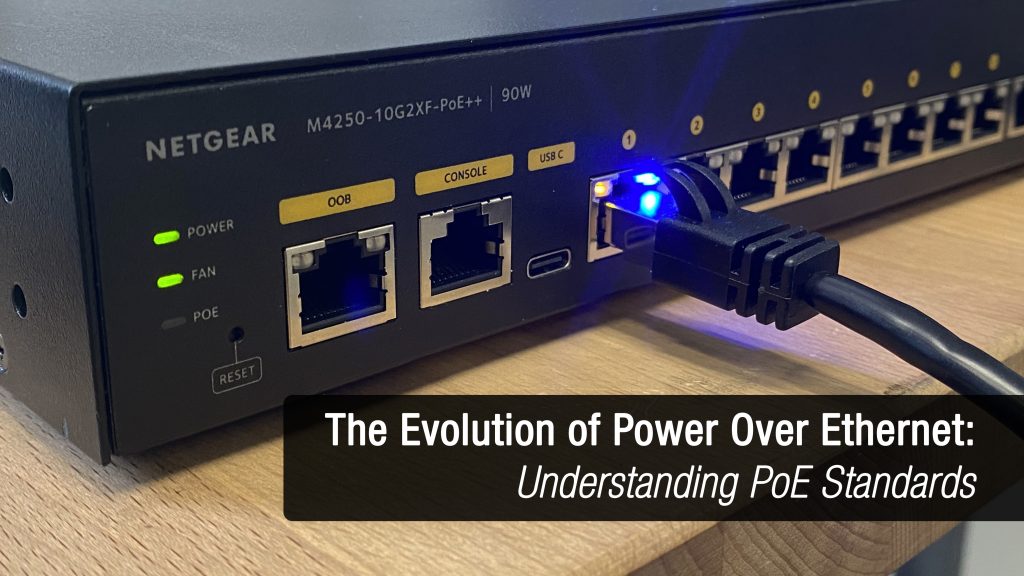Understanding the Differences: PoE+, PoE++ Type 3, and PoE++ Type 4
In the world of video production and networked devices, Power over Ethernet (PoE) technology has revolutionized the way we power and connect our equipment. By delivering both power and data over a single Ethernet cable, PoE simplifies installations, reduces cable clutter, and enhances flexibility. As PoE technology has evolved, new standards have emerged to meet the increasing power demands of modern devices. In this blog post, we’ll explore the differences between PoE+, PoE++ Type 3, and PoE++ Type 4, and how they can benefit your video production setup. Interested in knowing more about PoE technology? Check out this blog that goes over the basics of Power over Ethernet technology.
What is PoE?
Power over Ethernet (PoE) is a technology that allows Ethernet cables to carry electrical power in addition to data. This eliminates the need for separate power supplies and reduces the number of cables required for networked devices. PoE is commonly used in applications such as IP cameras, wireless access points, and VoIP phones. The original PoE standard 802.3af, developed in 2003, only allowed for a maximum of 15W of power, but would continue to evolve and improve with time. Below we will briefly cover each PoE+ standard and their capabilities.
PoE+ (802.3at)
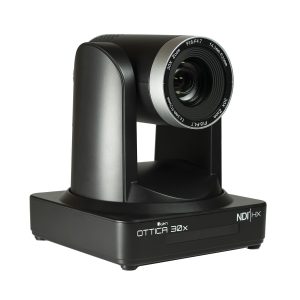
PoE+, also known as 802.3at, is an enhanced version of the original PoE standard (802.3af). It provides more power to connected devices, making it suitable for a wider range of applications.
- Power Output: PoE+ can deliver up to 25.5 watts of power per port.
- Voltage: Typically operates at 50-57 volts.
- Applications: Ideal for devices that require more power than what standard PoE can provide, such as PTZ cameras, video conferencing systems, and advanced wireless access points.
PoE++ Type 3 (802.3bt)
PoE++ Type 3, also known as 802.3bt Type 3, is a further advancement in PoE technology. It significantly increases the power output, allowing for even more demanding devices to be powered over Ethernet.
- Power Output: PoE++ Type 3 can deliver up to 60 watts of power per port.
- Voltage: Typically operates at 50-57 volts.
- Applications: Suitable for high-power devices such as multi-radio wireless access points, high-definition PTZ cameras, and digital signage displays.
PoE++ Type 4 (802.3bt)
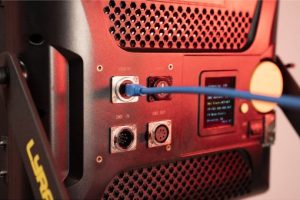
PoE++ Type 4, also known as 802.3bt Type 4, is the latest and most powerful PoE standard. It provides the highest power output, making it capable of supporting the most power-hungry devices.
- Power Output: PoE++ Type 4 can deliver up to 100 watts of power per port.
- Voltage: Typically operates at 50-57 volts.
- Applications: Ideal for ultra-high-power devices such as video conferencing systems with multiple monitors, large digital signage displays, and advanced networked lighting systems.
The Netgear M4250 series AV Line network switches are specially designed for AV over IP applications in professional AV environments such as corporate offices, education institutions and more. Equipped with PoE++ Type 4 compatibility, the versatile M4250 line presents a range of switches to accommodate different lighting configurations and power needs seamlessly. Ikan is proud to work closely with Netgear in developing compatibility with our PoE Lights, and we currently offer bundles of our Lyra POE LED Soft Lights with Netgear M4250 network switches included.
Key Differences
- Power Output:
- PoE+: Up to 25.5 watts per port.
- PoE++ Type 3: Up to 60 watts per port.
- PoE++ Type 4: Up to 100 watts per port.
- Applications:
- PoE+: Suitable for mid-range power devices like PTZ cameras and advanced wireless access points.
- PoE++ Type 3: Suitable for high-power devices like multi-radio wireless access points and high-definition PTZ cameras.
- PoE++ Type 4: Suitable for ultra-high-power devices like video conferencing systems with multiple monitors and large digital signage displays, studio lighting fixtures.
- Voltage: All three standards typically operate at 50-57 volts, ensuring compatibility with a wide range of networked devices.
Why Choose the Right PoE Standard?
Choosing the right PoE standard for your video production setup is crucial for ensuring that your devices receive adequate power and operate efficiently. As PoE technology has advanced, introducing higher power outputs and greater capabilities, it has become an even more versatile solution for media production. Using a higher PoE standard can also future-proof your network, allowing you to add more powerful devices without needing additional power sources.
Ikan International and PoE Technology
At Ikan International, we understand the importance of reliable and efficient power solutions for video production. Our range of PoE-compatible products, including PTZ cameras and networked video equipment, are designed to take full advantage of PoE technology. Whether you’re setting up a small studio or a large-scale production environment, our products ensure seamless integration and optimal performance.
Ikan’s PoE Lighting Fixtures
Ikan International has recently unveiled its innovative Power over Ethernet (PoE) lighting products, the LBX8-POE and LBX10-POE. These state-of-the-art lights are set to transform the industry, offering unparalleled convenience and efficiency.
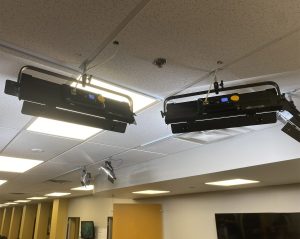
- LBX8-POE:
- Power Delivery: Supports IEEE 802.3bt Type 4 PoE++ standard.
- Lighting Quality: Equipped with 97 CRI LED chips and a soft panel, emitting a gentle, wraparound light with a 110-degree beam angle.
- Color Temperature: Adjustable from 3200K to 5600K.
- Design: Ideal for spaces with low-ceiling clearance, such as classrooms and conference rooms.
- LBX10-POE:
- Power Delivery: Supports IEEE 802.3bt Type 4 PoE++ standard.
- Lighting Quality: Similar to the LBX8-POE, with 97 CRI LED chips and a soft panel, providing even and consistent lighting.
- Color Temperature: Adjustable from 3200K to 5600K.
- Versatility: Suitable for professional studios, on-location shoots, and various other spaces.
These PoE lighting fixtures eliminate the need for additional wiring or power outlets, significantly saving time and reducing installation costs. They promote a cleaner and more organized workspace, making them perfect for professional broadcast lighting.
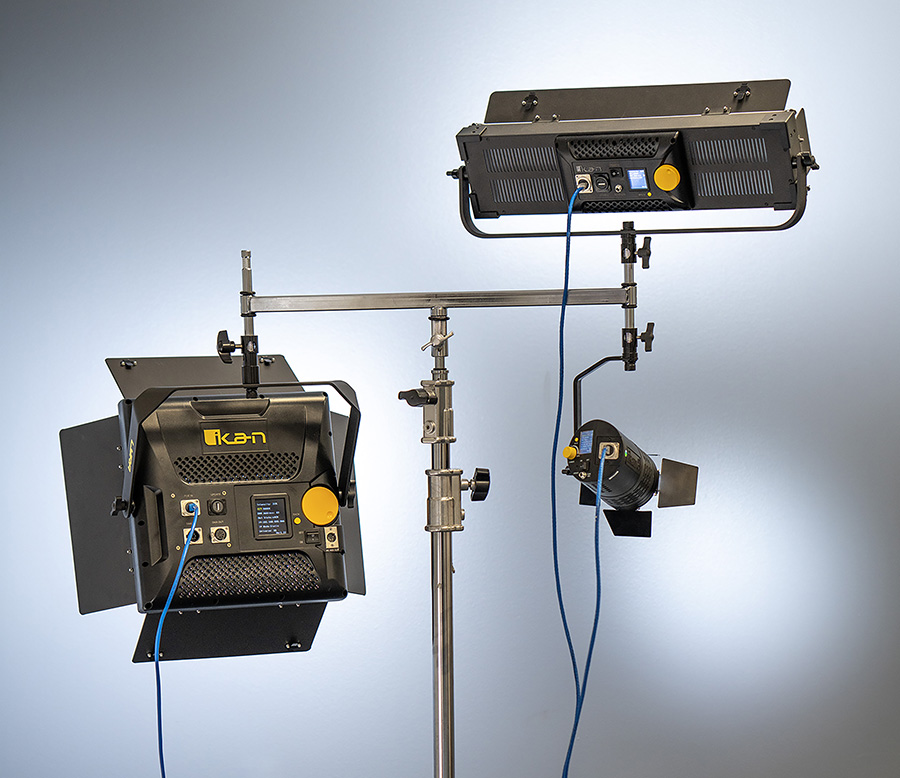 Understanding the differences between PoE+, PoE++ Type 3, and PoE++ Type 4 is essential for selecting the right power solution for your networked devices. By choosing the appropriate PoE standard, you can ensure that your video production setup is both efficient and future-proof. At Ikan International, we’re committed to providing cutting-edge solutions that meet the evolving needs of the video production industry, including our innovative PoE lighting fixtures.
Understanding the differences between PoE+, PoE++ Type 3, and PoE++ Type 4 is essential for selecting the right power solution for your networked devices. By choosing the appropriate PoE standard, you can ensure that your video production setup is both efficient and future-proof. At Ikan International, we’re committed to providing cutting-edge solutions that meet the evolving needs of the video production industry, including our innovative PoE lighting fixtures.
For more information on our PoE-compatible products and how they can enhance your video production setup, visit Ikan International.
Check out these videos from the 2024 NAB Show Fireside Chats at the Ikan International booth, CEO James Tian sits down with key figures involved in the broadcast industry to get their thoughts on Ikan’s new PoE LED Lights.

